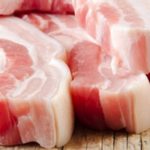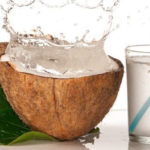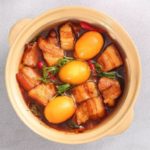Coconut is a versatile fruit with numerous varieties found in Vietnam, each offering unique characteristics and uses such as refreshments, baking, desserts, and crafts. Let’s explore some of these diverse coconut types and their distinct features.
1 Xiem Green Coconut
Xiem Green Coconut, known for its refreshing water, is the most popular drinking coconut in the Mekong Delta. With its thin, green shell, the coconut offers a sweet and refreshing taste (7-7.5% sugar content), providing up to 350ml of water per fruit.
This variety typically yields 140-150 coconuts per tree per year. Xiem Green Coconuts are priced at 15,000 to 20,000 VND each. You can also enjoy their sweetness by purchasing canned products.
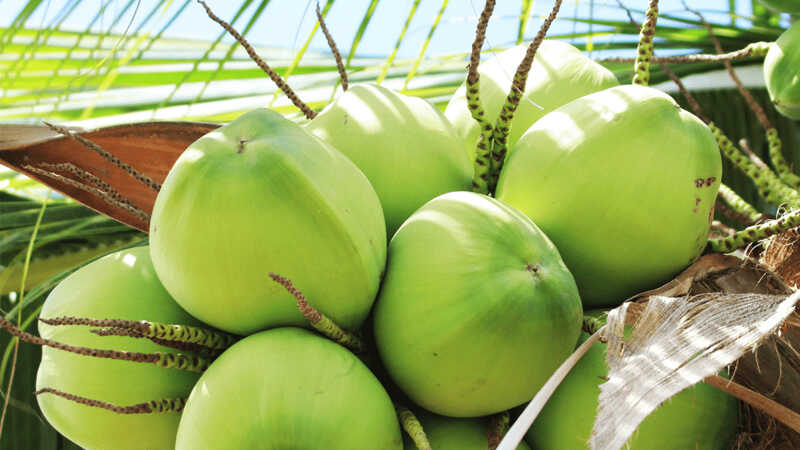 Xiem Green Coconut
Xiem Green Coconut
2 Xiem Dwarf Coconut
Xiem Dwarf Coconut, also known as Xiem Chu, is an older variety that has recently been renamed to distinguish it from other Xiem coconuts. Many locals in and around Ben Tre province still refer to this variety as Xiem Luc.
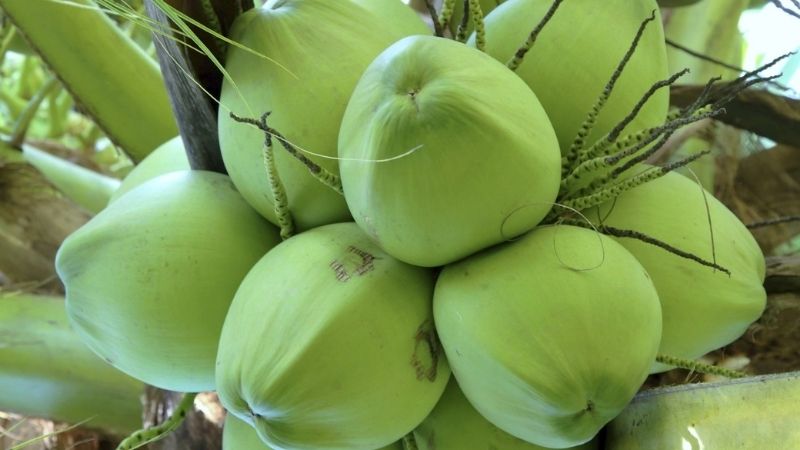 Xiem Dwarf Coconut
Xiem Dwarf Coconut
The fruit has a lighter green color, tending towards a greenish-yellow. Xiem Dwarf Coconuts have two nang mo, and their thin shells yield a generous amount of water. Notably, this variety produces more coconuts than the Xiem Green, with an average of over a dozen coconuts per cluster.
Xiem Dwarf Coconuts are priced at 11,000 to 20,000 VND each.
3 Xiem Red Coconut
The Xiem Red Coconut stands out with its brown shell, and its water offers a sweet and refreshing taste (7-7.5% sugar content), providing 250-350ml of water per fruit. This variety is widely consumed.
The dried coconut meat of the Xiem Red is used to extract oil and in the production of cakes, candies, and animal feed or fertilizer.
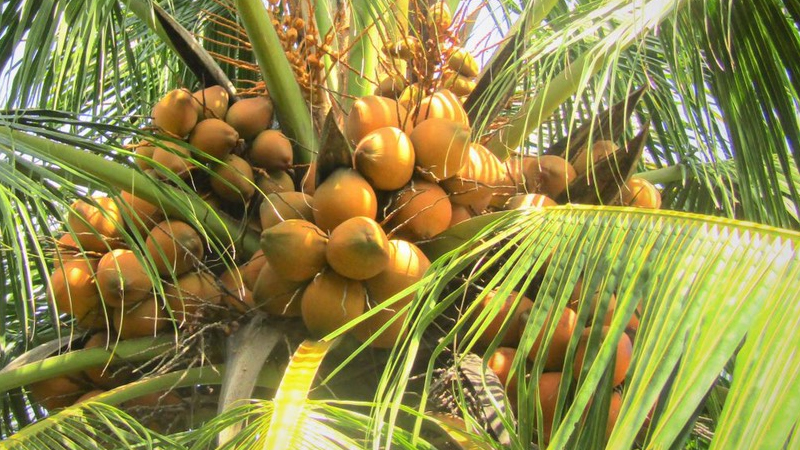 Xiem Red Coconut
Xiem Red Coconut
Additionally, dried Xiem Red coconut meat is a stable export product, contributing significantly to economic growth. Even the coconut shells are utilized to create eye-catching handicrafts. Xiem Red Coconuts are priced at 15,000 to 20,000 VND each.
4 Xiem Luc Coconut
Xiem Luc Coconut is renowned for producing the sweetest and most delicious coconut water among all varieties. Its thin shell has a deep green color, and the water is exceptionally sweet (8-9% sugar content), providing 250-300ml of water per fruit.
Xiem Luc Coconut is one of the most favored varieties in the market. It is priced at 13,000 to 19,000 VND each.
 Xiem Luc Coconut
Xiem Luc Coconut
5 Xiem Fire Coconut
The Xiem Fire Coconut gets its name from its vibrant yellow-orange shell, resembling fire. This variety is highly productive, yielding 140-150 coconuts per tree per year.
Although the fruit is slightly smaller, it still provides a substantial amount of water, ranging from 250-300ml per fruit, with a sweet taste (6.5-7% sugar content). Xiem Fire Coconuts are ideal for both drinking and eco-tourism purposes.
They are priced at 10,000 to 15,000 VND each.
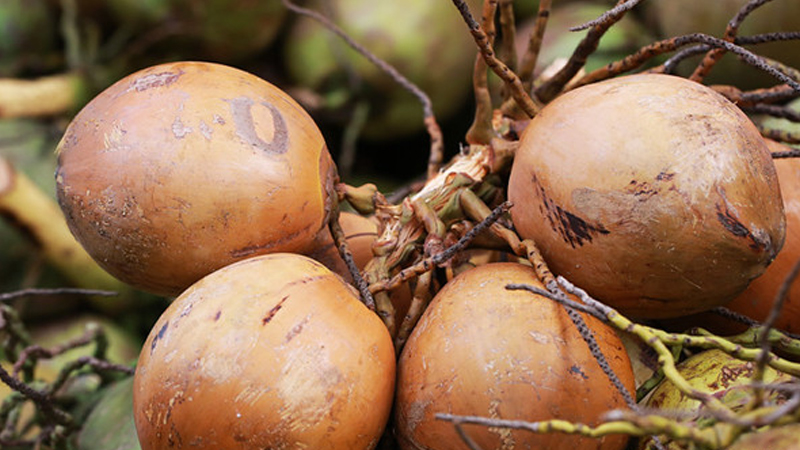 Xiem Fire Coconut
Xiem Fire Coconut
6 Xiem Knob Coconut
Xiem Knob Coconut is distinguished by its exceptionally sweet and tasty water (8 – 8.5% sugar content) and an average yield of 100 – 120 coconuts per tree per year.
The fruit has a green shell, and a distinctive small knob protrudes from the bottom. Each coconut provides 250 – 350ml of water. This variety is cultivated in small quantities in Hung Phong, Giong Trom, and a few other locations.
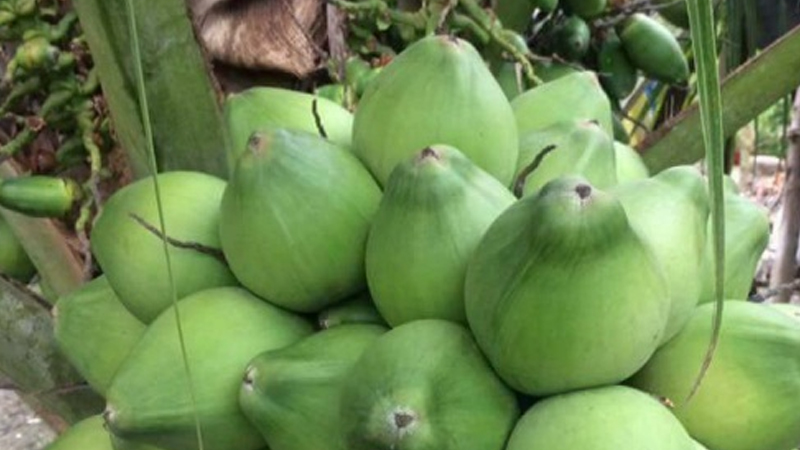 Xiem Knob Coconut
Xiem Knob Coconut
7 Malay Coconut
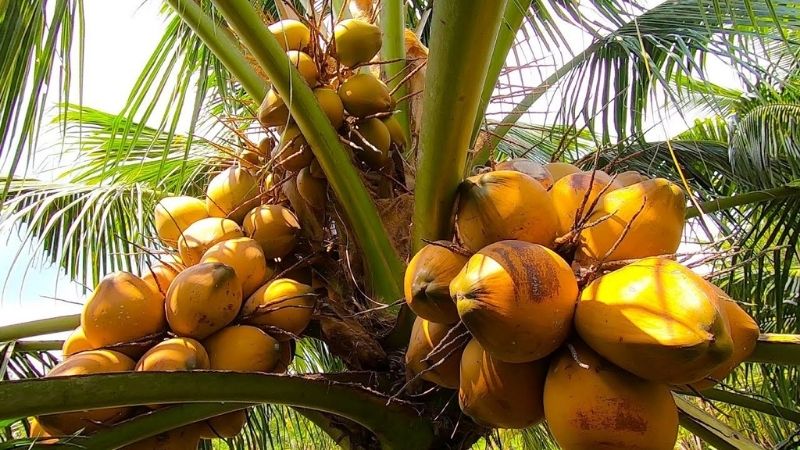 Malay Coconut
Malay Coconut
The Malay Coconut, also known as the Malaysian Coconut or Xiem Red Coconut (scientific name: Cocos Nucifera), is a newer variety cultivated in certain areas of the Mekong Delta. Due to its superior yield and high economic value, the Malay Coconut is receiving long-term investment for further development.
Despite bearing smaller fruits, the Malay Coconut yields an abundant amount of water that rivals the sweetness of the Xiem Coconut.
Malay Coconuts are priced at 10,000 to 15,000 VND each.
8 Strawberry Coconut (Red Strawberry Coconut)
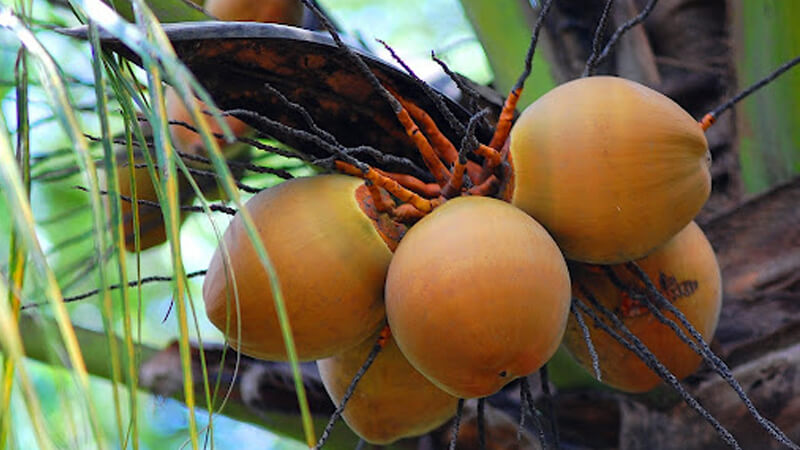 Strawberry Coconut (Red Strawberry Coconut)
Strawberry Coconut (Red Strawberry Coconut)
The Strawberry Coconut is the second most common tall coconut variety in Vietnam, after the Vietnamese Coconut.
The fruit is round and comes in three colors: green, yellow, and red. This variety has an average yield of 70-80 coconuts per tree per year, with a medium size, 10 – 12mm thick coconut meat, and a fresh weight of 300-400g. It boasts a high oil content (63%-65%).
Strawberry Coconuts are priced at 10,000 to 15,000 VND each.
9 Vietnamese Coconut
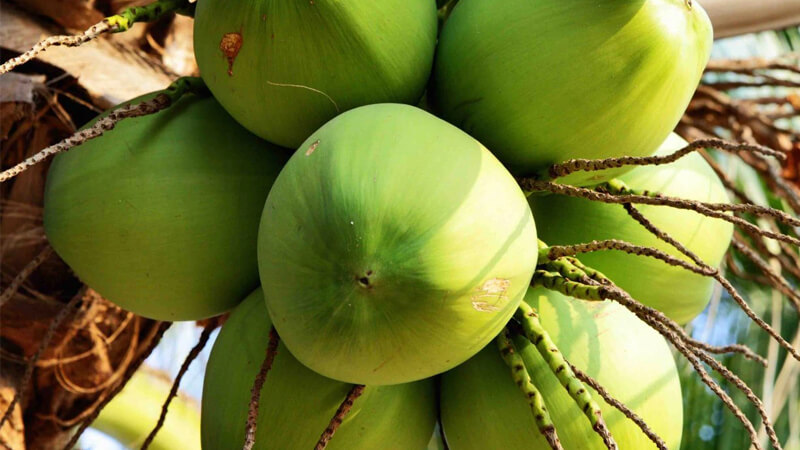 Vietnamese Coconut
Vietnamese Coconut
The Vietnamese Coconut is the most prevalent tall coconut variety in Vietnam, featuring three facets and three colors: green, yellow, and red (also known as fire coconut). With an average yield of 60-70 coconuts per tree per year, the Vietnamese Coconut boasts a large size, 11 – 13mm thick coconut meat, and a high oil content (63%-65%). It is priced at 10,000 to 15,000 VND each.
10 Pineapple Coconut
The Pineapple Coconut is another high-quality drinking coconut variety with significant economic value. All parts of the Pineapple Coconut emit a distinctive pineapple fragrance, explaining its name.
See also:
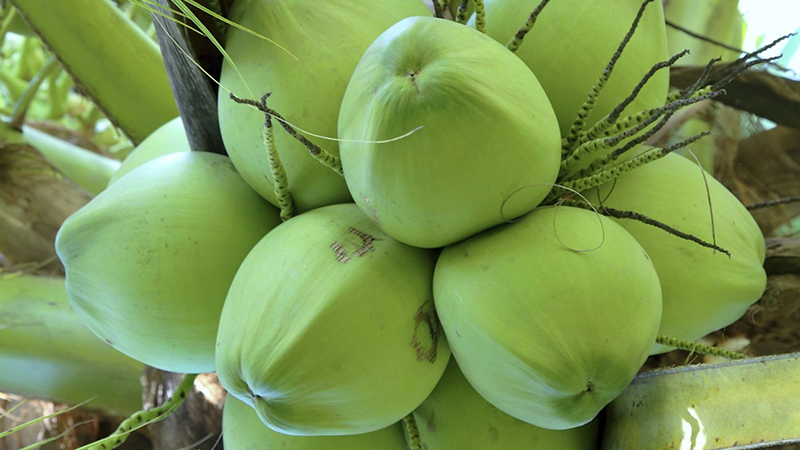 Pineapple Coconut
Pineapple Coconut
In the market, Pineapple Coconuts are categorized into three groups:
-
Group I: Round-shaped with a small size, green shell, very sweet water (8 – 8.5% sugar content), and the strongest fragrance.
-
Group II: Medium-sized with a green shell, moderately sweet water (7 – 7.5% sugar content), and a mild fragrance.
-
Group III: Large size similar to the Vietnamese Coconut, with a green or yellow shell, moderate sweetness (6 – 6.5%), and the mildest fragrance among the three groups.
Pineapple Coconuts are priced at 15,000 to 20,000 VND each.
11 Wax Coconut
The Wax Coconut, also known as Special Meat Coconut or Cream Coconut, has a unique characteristic: its meat is soft and spongy, and its water is thick and sticky, with a delightful fragrance. Wax Coconuts are used in various desserts, cakes, candies, and even coconut cream, imparting a distinctive flavor.
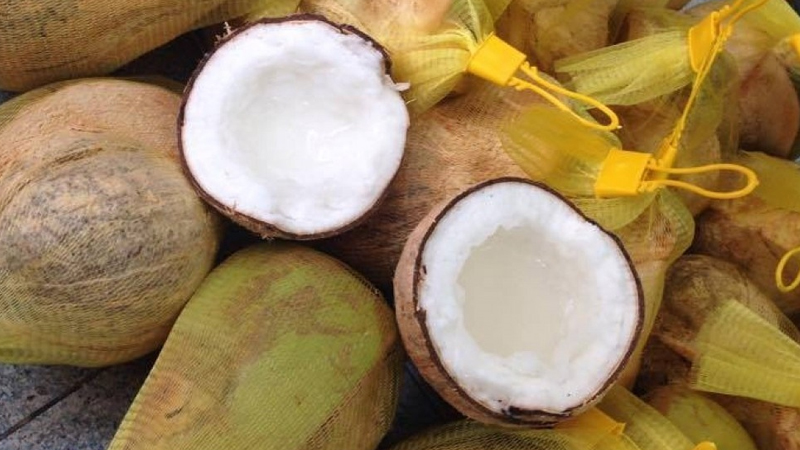 Wax Coconut
Wax Coconut
Externally, the Wax Coconut tree and fruit appear no different from regular coconuts. To identify a Wax Coconut, one must shake the fruit; if it doesn’t make a sound or produces a muffled sound, it is likely a Wax Coconut.
Wax Coconuts are predominantly cultivated in Hoa Tan, Cau Ke district, Tra Vinh province, and neighboring provinces.
In Vietnam, there are two types of Wax Coconuts:
-
Type 1: The coconut meat is similar in thickness to regular coconuts, but it is softer, and the water is slightly thicker. This type usually has larger fruits, resembling the Vietnamese Green Coconut or a round, brown coconut.
-
Type 2: The coconut meat is thicker, with two distinct layers: the outer layer is soft like mush, and the inner layer is fluffy like cotton. The water is very thick and white. This type has round fruits, similar in size to the Green Strawberry Coconut.
Due to their rarity and exceptional quality, Wax Coconuts are priced higher, ranging from 150,000 to 250,000 VND each.
12 Water Coconut (Leaf Coconut)
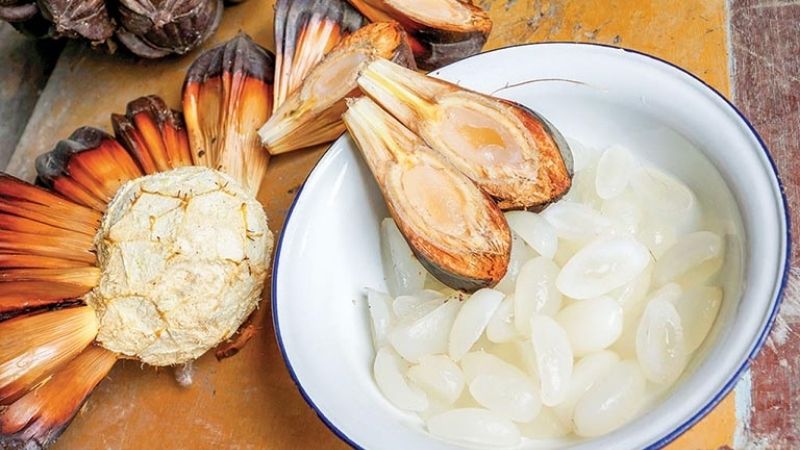 Water Coconut (Leaf Coconut)
Water Coconut (Leaf Coconut)
The Water Coconut is a distinctive tree found in the Mekong Delta, commonly growing along rivers and brackish canals.
Water Coconuts have white, soft, sweet, and refreshing meat, making them ideal for creating cooling and thirst-quenching dishes. They are priced at 12,000 to 15,000 VND each.
13 Tam Quang Coconut
The Tam Quang Coconut, originating from Tam Quang in Binh Dinh province, is a visually appealing variety cultivated for its drinking water.
It has a thin, bright yellow shell, and its water offers a sweet taste (7.5 – 8% sugar content), providing 250-350ml of water per fruit.
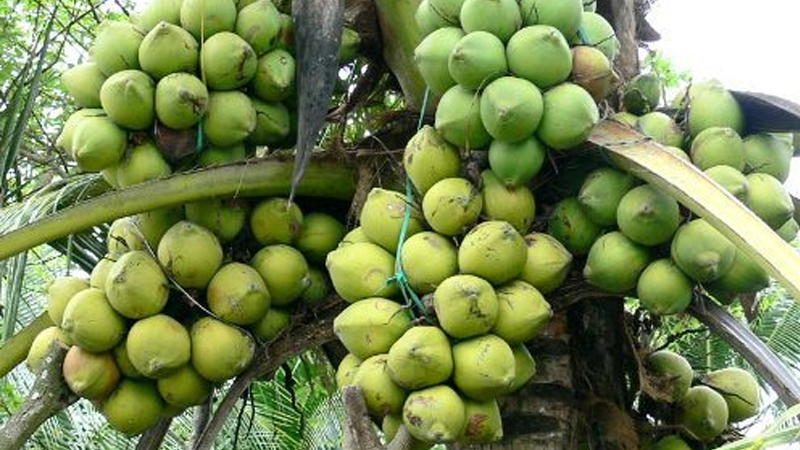 Tam Quang Coconut
Tam Quang Coconut
According to folk beliefs, the Tam Quang Coconut possesses cooling properties and can be used for medicinal purposes. It is also sought after during festive seasons for its auspicious significance in feng shui and worship.
Tam Quang Coconuts are priced at 13,000 to 19,000 VND each.
14 Brown Brittle Coconut (Red Brittle Coconut)
The Brown Brittle Coconut is a drinking coconut variety known for its high yield, producing 250-300 coconuts per tree per year.
The fruit is small, with a brown shell similar to the Xiem Red
Tips for Selecting the Best Coconut
Are you looking for delicious, refreshing coconut water? Do you want to find out which coconuts offer the best combination of nutritional value and taste? We will help you out with this guide, as we provide you tips on how to select sweet and watery coconuts packed with essential vitamins (A and E) and minerals (calcium and potassium), among others.


























